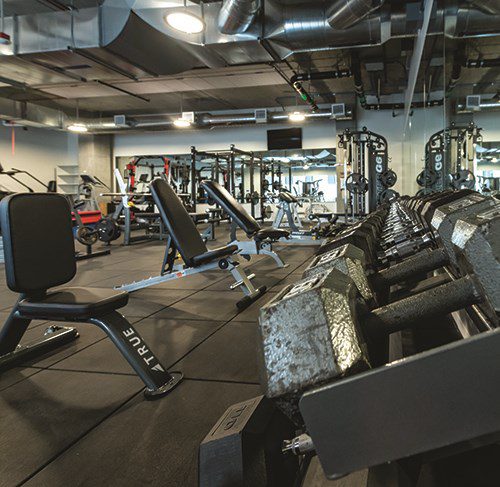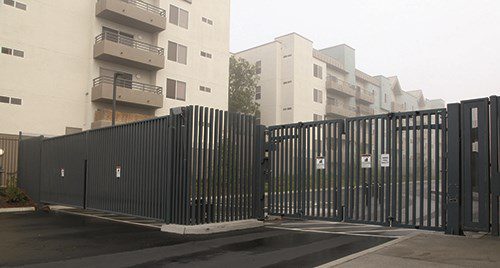The Los Angeles Airport Police Division (LAXPD) now has a home befitting of its status as the largest airport law enforcement agency in the United States. The 1,100-member department moved into a new $216 million facility on the north side of Los Angeles International Airport (LAX) in fall 2021.
The Los Angeles Airport Police Division (LAXPD) now has a home befitting of its status as the largest airport law enforcement agency in the United States. The 1,100-member department moved into a new $216 million facility on the north side of Los Angeles International Airport (LAX) in fall 2021.
 The 160,000-square-foot, largely concrete-and-glass facility is as “green” as it is sleek and modern. More importantly, however, it consolidates various LAXPD teams and units that had been housed in eight separate facilities scattered across the airport’s 6,500-acre campus. Personnel previously shoehorned into trailers and isolated offices are especially happy to be united with the rest of the force.
The 160,000-square-foot, largely concrete-and-glass facility is as “green” as it is sleek and modern. More importantly, however, it consolidates various LAXPD teams and units that had been housed in eight separate facilities scattered across the airport’s 6,500-acre campus. Personnel previously shoehorned into trailers and isolated offices are especially happy to be united with the rest of the force.
“A major benefit to this new facility is that our sworn and civilian staff now have a state-of-the-art work environment that incorporates the newest technology and brings everyone together under one roof,” says Justin Erbacci, chief executive officer of Los Angeles World Airports. “This allows for improved coordination and collaboration between all of our employees, as well as improved opportunities for training and engagement.”
|
facts&figures Project: New Police Facility Location: Los Angeles Int’l Airport Size: 160,000 sq. ft. Personnel Housed: 1,100 sworn & civilian employees Facility Cost: $216 million Funding: $201 million in bonds; $15 million of general airport revenue Construction: Oct. 2019-Sept. 2021 Design & Construction Management: Hensel Phelps Architect & Structural Engineer: Skidmore, Owings & Merrill
Relocation Management: Chrysalis Infrastructure Consultant: AECOM Electrical Contractor: Rosendin Electric Inc.
Mechanical Contractor: Critchfield Plumbing Contractor: Muir-Chase Plumbing Co. Parking Structure Construction: Bomel Construction Perimeter Security Gates: Wallace Perimeter Security Features: State-of-the art indoor shooting range; briefing rooms; classrooms; public multi-use room; gym with locker rooms; 33 electric-vehicle charging stations; parking structure with 960 stalls Eco-Friendly Attributes: LEED silver rating; significant use of sustainable/recycled & low-VOC materials; 15% of building contains recycled content; 86% construction waste was diverted from landfills; permeable pavement & pavers; high-performance windows; 40% less water usage & 27% less energy costs compared to similarly sized non-sustainably built facilities; roof-top solar panels; dual-piping for eventual use of reclaimed water; native, drought-resistant landscaping Key Benefits: Consolidating workforce previously scattered between 8 locations; enhanced communication, collaboration & efficiency |
The facility’s location on a 12-acre parcel of land adjacent to the north runways facilitates quick response times to the airfield and surrounding airport areas. “It also increases our visibility in the community, which in turn creates better community awareness and fosters stronger relationships with our neighbors,” adds Erbacci.
About $201 million of the $216 million project was funded by a bond issue. General airport revenue paid for the remainder. Construction started in October 2019 and finished last September.
All Together Now
Having the division’s various branches in one building will enhance communications and teamwork, explains Police Chief Cecil Rhambo Jr. Due to the size and scope of LAX, its police force includes many sub-groups, such as a bomb-disposal unit, K-9 teams, a traffic-and-security group, an emergency service SWAT team, Homeland Security and Intelligence personnel, a dispatch center, a support-services office and the LAXPD office of operations.
“It was very difficult to coordinate resources…and muster everyone together to have collaborative discussions about things like planning and deployment,” Rhambo says. “I used to do a lot of driving to get to meetings.”
AECOM, the infrastructure consulting firm selected for the project, helped remedy that situation. “It was very difficult from a command-and-control standpoint to have people in different office buildings and trailers,” says Lilith Terry, an AECOM vice president and lead project manager for the initiative at LAX. “Plus the existing headquarters was too small and not built as a police facility. So the goal was to bring all eight locations together in a purpose-built facility.”
Facility amenities include a parking structure with 960 stalls, a gym with locker rooms, an indoor shooting range, briefing rooms, classrooms, a public multi-use room and 33 electric-vehicle charging stations.
“It’s a beautiful building—very contemporary looking,” Terry remarks. “It has sealed-concrete floors and open ceilings, with exposed conduit and ducts. It’s also very simple design-wise, which maximized the available space.”
Room to Grow
The building is future-proofed for expansion, Rhambo points out.
 “Most buildings are too small by the time they open. But we will have plenty of room for expansion,” he advises.
“Most buildings are too small by the time they open. But we will have plenty of room for expansion,” he advises.
One of the facility’s standout features is its wirelessly operated indoor shooting range/practice facility, which Rhambo ranks as one of the best in the U.S.
“We really wanted to make sure that our officers had the most state-of-the-art facility to call home,” Erbacci says. “As this is one of the largest police facilities in the state, we wanted to make sure that it could provide opportunities for both indoor and outdoor training. We actually can drive a vehicle into the range so our officers can train in, out of and around a vehicle during firearms and tactical training.”

Looking ahead, Rhambo says the new police facility could act as a model for aviation security training. “We’d like to run technical pilot programs for things such as drone detection and mitigation and perimeter security,” he explains.
LEED Certification
Eco-friendly features earned the building a silver rating in the Leadership in Energy and Environmental Design (LEED) program run by the U.S. Green Building Council.
“We are very proud that the facility was built with an eye towards sustainability…and has so many elements that help conserve water and energy,” Erbacci says.
The building was constructed from a significant amount of sustainable/recycled materials such as concrete, drywall, insulation, roofing, plaster, carpeting, acoustic ceiling tiles and exterior metal panels. In fact, 15% of the building contains recycled content, and 86% of the construction waste was diverted from landfills.
The project team further enhanced the facility’s environmental quotient by using materials such as paint, sealants, flooring, ceiling tiles and insulation made with low levels of volatile organic compounds.

Other “green” features include:
- permeable pavement, which absorb rainwater and divert it from storm sewers;
- high-performance windows that help minimize “hot-spots” and increase thermal comfort;
- 40% less water usage;
- 27% reduction in energy costs compared to a similarly sized but non-sustainably built facilities;
- roof-top solar panels that can generate 75 kilowatts of electricity;
- dual-piping for eventual use of reclaimed water, which will be used for irrigation, toilets and urinals; and
- landscaping with drought-resistant plants native to California.
Moving Logistics
Transferring a workforce from one building to another is a big undertaking for any organization. Moving law enforcement units from several different locations into one posed even a bigger challenge. To get ahead of that curve, LAX retained the services of Chrysalis Global Aviation, a change- and relocation-management consultant.
 “Over the years, everyone at those eight locations had adapted their own processes for their particular facilities,” explains Suzanne Phelps, managing partner at the company. “But now they’re all co-located…so we had to take into account all their needs to maintain organizational management. Procedures and processes had to change, so we helped them through that.”
“Over the years, everyone at those eight locations had adapted their own processes for their particular facilities,” explains Suzanne Phelps, managing partner at the company. “But now they’re all co-located…so we had to take into account all their needs to maintain organizational management. Procedures and processes had to change, so we helped them through that.”
Chrysalis also helped employees determine what to move into the new building and what to eliminate.
Moving employees that have been in the same facilities for decades is much like moving a family out of their longtime home, adds Ann Thorvik, a director at Chrysalis.
“They each have to take a look at what they have, what they truly need and can’t live without and whether there’s enough space for it in their new space,” Thorvik says. “There wasn’t as much storage space in the new place, so moving required some discipline.”

The relocation also required a carefully coordinated approach.
“You can’t just shut things down for a night and move everything over,” she notes. “Maybe you have to move half a department at a time, so it remains operational. We moved departments in digestible chunks and gave the IT people a chance to successfully hook up equipment.
“We made sure everything was operating flawlessly before moving the rest of a department.”
Because the move would mark the first time the entire police force worked together in one place, there were logistical issues to resolve, such as where to centrally locate shared printers, paper shredders and other machines.
“A lot of these things seem rather mundane, but they strongly impact employees’ abilities to do their day-to-day jobs well,” Thorvik says.
Keys to Success
Many elements factor into a successful project of this magnitude, and Erbacci ranks community relations as critical.
“The LAX footprint is quite small, despite being one of the busiest airports for passenger traffic,” he explains. “Plus, we’re surrounded by El Segundo to the south, Inglewood to the east and Westchester to the north. When you’re close to your neighbors and move forward with projects that are adjacent to local communities, it’s imperative that you engage directly with these communities and local elected officials through every step of the process.
“From public meetings to stakeholder updates and construction advisories, we engaged the local community and provided updates during every phase of the project.”
Phelps advises clients to not wait to make decisions.
“What to get rid of, how many people to put on the first floor of the building…it’s really important to not let those issues linger,” she says. “Any decisions left to stagnate will jeopardize the project timeline.
“It’s also very important to be transparent,” she adds. “Bad news does not age well. It’s better to set expectations realistically at the front end of the project and be transparent throughout, so that at the end, everyone is pulling in the same direction.”
 Terry says one reason the project went smoothly was the facility’s site: a vacant piece of land that had been designated years ago for another terminal that wasn’t built.
Terry says one reason the project went smoothly was the facility’s site: a vacant piece of land that had been designated years ago for another terminal that wasn’t built.
“There was no competition for space because the parcel is by itself, away from the terminals,” she says.
Terry also credits the quality of the project team. “It wasn’t a low-bid project,” she relates. “Instead, vendors were selected based on value, which allowed us to select who we thought would create the best team.
“Furthermore the design team was very collaborative, which allows a project to go that much more smoothly.”
 Kyle Hoffman, project manager from Hensel Phelps, notes that early planning and collaboration with end-users also was critical. “If you start down the wrong path and then have to pivot later, you’ve wasted days—sometimes even weeks and months,” he says. “I give kudos to both the city (Los Angeles, which owns and operates the airport) and airport officials for facilitating easy access to the actual end-users.
Kyle Hoffman, project manager from Hensel Phelps, notes that early planning and collaboration with end-users also was critical. “If you start down the wrong path and then have to pivot later, you’ve wasted days—sometimes even weeks and months,” he says. “I give kudos to both the city (Los Angeles, which owns and operates the airport) and airport officials for facilitating easy access to the actual end-users.
“Planning is always an obvious success factor,” Hoffman adds. “But access to end-users also is very meaningful.”
Then & Now
Erbacci and Rhambo are both very pleased with the new facility, noting it is a far cry from the old, roughly 20,000-square-foot main facility sandwiched between a long-term parking lot and a cellphone parking lot.
The department included about 200 officers when the division moved into that building. Its restrictive size was the reason LAXPD had to spread out as its ranks grew.
“Although we had learned to adapt to working from these multiple locations, we knew that building a consolidated facility would create opportunities for better coordination between units and with our partners, improve our efficiency and allow us to be nimble far into the future,” Erbacci observes.
“I think we’re already seeing success as our sworn and civilian staff enthusiastically work out of this new facility,” he continues. “Everything is brand new and reflects our commitment to the safety of our passengers, guests, employees and community.”
“It’s certainly something we’re very proud of,” Rhambo adds. “I think it’s a model facility that the aviation world will emulate.”



